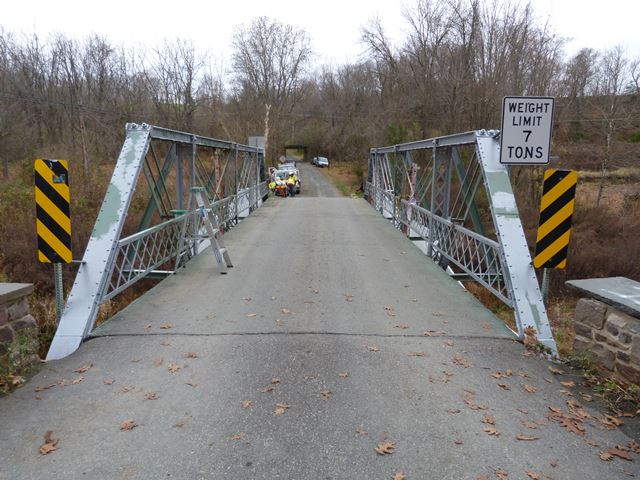We Recommend:
Bach Steel - Experts at historic truss bridge restoration.
BridgeHunter.com Phase 1 is released to the public! - Visit Now
Hamp Road Bridge

Primary Photographer(s): Nathan Holth
Bridge Documented: November 7, 2015
Rural: Hunterdon County, New Jersey: United States
By Builder/Contractor: Wrought Iron Bridge Company of Canton, Ohio
1994
54.0 Feet (16.5 Meters)
55.0 Feet (16.8 Meters)
13 Feet (3.96 Meters)
1 Main Span(s)
10WD120

View Information About HSR Ratings
Bridge Documentation
View Archived National Bridge Inventory Report - Has Additional Details and Evaluation
This bridge has a lot of welded alterations, however it also retains the original distinctive design details of its original builder. Specifically this is at the top chord and end post connection where there is a threaded rod with nut style connection instead of a pin connection for the diagonal, and also there are cast iron elements on the sides of these connections. These two details were used by the Wrought Iron Bridge Company.
At the time of documentation this bridge was being repainted. Hunterdon County is one of the only counties in the United States that actually properly maintains the paint systems on its many historic truss bridges. In the photos seen on this website, the bridge is silver because only the primer has been applied. The final top coat for bridges in this county is green.
Information and Findings From New Jersey's Historic Bridge InventorySummary The 4-panel pin-connected half hip Pratt pony truss bridge is supported on random ashlar abutments with wingwalls. The diagonals are joined to the chords and through bearing assembly with cast iron connectors, a detail found on another WIBC span in the county (10XXL95). This span is well preserved, and it is one of the most distinctive and complete examples of the over 20 Pratt half hip pony trusses in the county. Its state of preservation and construction details make it significant. Physical Description The four-panel, pin-connected, half-hip Pratt pony truss bridge is supported on random ashlar abutments with wingwalls. The top chord and inclined end posts are riveted box members composed of shallow channels, toe out, with cover plates and widely spaced battens. Vertical members are back-to-back angles joined by lattice. The bottom chord and diagonals are stamped roundheaded eyebars. Pin connections are through gusset plates riveted to the vertical ends. An unusual feature is the cast iron bearing shoes with rollers at both the expansion bearing plate and the fixed end. Cast iron connectors are also used for the node connecting the inclined end posts and top chord. The diagonals pass through the node and are secured by bolts. The original lattice railings remain. Alterations are not intrusive and include the addition of outriggers, small welded reinforcing plates at panel points, duplicate diagonals welded to the outside of the top chords in the end panels, and small repairs. A new deck has been added. The bottom chord appears to be sprung. Historical and Technological Significance Although the fabricator and date of construction are not documented, the ca. 1895 pin-connected Pratt pony truss bridge appears to be very like the "Low Truss, Half Slope End Posts" bridge described in the 1885 Wrought Iron Bridge Company Illustrated Pamphlet. The castings used at the bearings and the node between the end posts and top chord are unusual construction details that distinguish the span as technologically significant (criterion C). The span, one of over 20 Pratt half hip pony truss bridges in Hunterdon County, is a valuable example of both an important local bridge type and idiosyncratic details. It is attributed to The Wrought Iron Bridge Company based on those details. The Wrought Iron Bridge Company of Canton, Ohio was founded in 1864 by David Hammond, and it was incorporated in 1871. It operated as such until 1899, when it was absorbed by the American Bridge Company (Darnell, 48.) By the use of illustrated catalogues and through the efforts of traveling bridge agents, distant fabricators were able to successfully compete with local contractors for the county award of bridge contracts. WIBC was one of the most successful late-19th century bridge companies, and their bridges are not uncommon in the state. This example is distinguished by its relatively good state of preservation, integrity of setting, and distinctive details. The modifications do not preclude the span from functioning as originally designed, and they do not outweigh the significance of the seldom-seen details. Boundary Description and Justification The bridge is located on an unimproved road in a rural area that was not evaluated for historic district potential. There are no above-ground resources adjacent to the bridge, which is individually distinguished. The boundary is thus limited to the substructure and superstructure of the span itself. Sources Darnell, Victor C. A Directory of American Bridge-Building Companies, 1840-1900. Washington D.C.: Society for Industrial Archeology, 1984. Bridge Considered Historic By Survey: Yes |
![]()
Photo Galleries and Videos: Hamp Road Bridge
Bridge Photo-Documentation
Original / Full Size PhotosA collection of overview and detail photos. This gallery offers photos in the highest available resolution and file size in a touch-friendly popup viewer.
Alternatively, Browse Without Using Viewer
![]()
Bridge Photo-Documentation
Mobile Optimized PhotosA collection of overview and detail photos. This gallery features data-friendly, fast-loading photos in a touch-friendly popup viewer.
Alternatively, Browse Without Using Viewer
![]()
Maps and Links: Hamp Road Bridge
Coordinates (Latitude, Longitude):
Search For Additional Bridge Listings:
Bridgehunter.com: View listed bridges within 0.5 miles (0.8 kilometers) of this bridge.
Bridgehunter.com: View listed bridges within 10 miles (16 kilometers) of this bridge.
Additional Maps:
Google Streetview (If Available)
GeoHack (Additional Links and Coordinates)
Apple Maps (Via DuckDuckGo Search)
Apple Maps (Apple devices only)
Android: Open Location In Your Map or GPS App
Flickr Gallery (Find Nearby Photos)
Wikimedia Commons (Find Nearby Photos)
Directions Via Sygic For Android
Directions Via Sygic For iOS and Android Dolphin Browser
USGS National Map (United States Only)
Historical USGS Topo Maps (United States Only)
Historic Aerials (United States Only)
CalTopo Maps (United States Only)

